10 animals with long tongues and the surprising ways they use them
The animal kingdom never ceases to amaze us with its incredible adaptations, and one of the most intriguing is the long tongue. From the lightning-fast strike of a chameleon to the deep-reaching tongue of a giant anteater, these remarkable organs serve vital roles in feeding, communication, and survival. Some species use their tongues to sip nectar or catch insects, while others rely on them to clean, groom, or even defend. Each is a masterpiece of evolution, shaped perfectly for its purpose. Discover ten fascinating animals with extraordinarily long tongues, nature’s true marvels of flexibility, precision, and design.

From giraffes to chameleons: Discover animals with long tongues
1. Giraffe
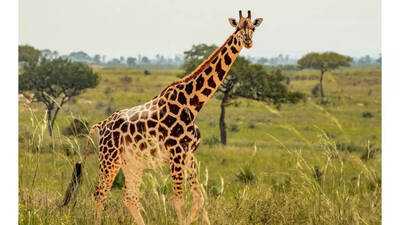
The giraffe boasts one of the longest tongues in the animal kingdom, stretching up to 45-50 centimetres. This dark blue-black tongue is prehensile, meaning it can grasp and wrap around objects, ideal for plucking leaves from thorny acacia trees. The dark pigment is believed to protect it from the harsh African sun while feeding for hours each day. Giraffes use their tongues with incredible dexterity, stripping leaves while avoiding sharp thorns. This adaptation not only allows them to reach high foliage inaccessible to other herbivores but also helps sustain their plant-based diet throughout dry seasons.
2. Giant Anteater
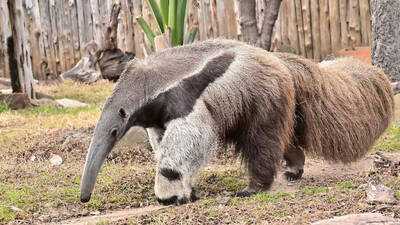
The giant anteater has a tongue that can extend up to 60 centimetres, allowing it to raid ant and termite colonies with ease. Lacking teeth, it relies on its sticky, slender tongue, covered in tiny backwards-facing spines and thick saliva, to lap up thousands of insects each day. Its tongue flicks in and out at incredible speed, as many as 150 times per minute, making it one of the fastest in the mammalian world. Uniquely, the anteater’s tongue is anchored near its sternum rather than its throat, giving it extraordinary reach inside narrow nests.
3. Chameleon
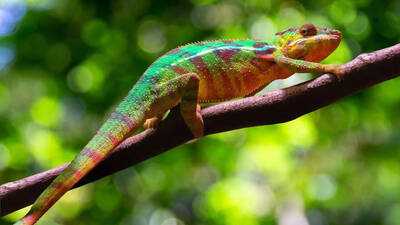
Chameleons possess tongues that are as impressive for their length as for their speed. Their elastic tongues can extend up to twice the length of their body, launching outward in less than a second to snatch unsuspecting insects. At the tip, a suction-cup-like pad helps them grasp their prey securely. This lightning-fast mechanism is driven by specialised muscles and elastic tissue that store energy like a spring, making the chameleon's feeding one of nature’s most precise predatory feats. Their tongue is a perfect example of evolution blending power, precision, and speed.
4. Sun Bear
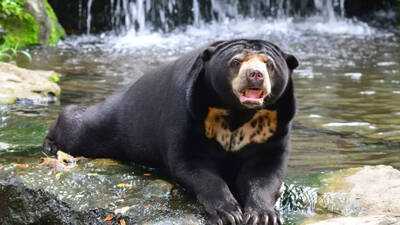
The sun bear, the smallest of the bear species, is also famous for its unusually long tongue, which can reach up to 25 centimetres. This adaptation is essential for feeding; the bear uses it to probe deep into tree trunks, termite mounds, and beehives to extract insects and honey. Its slender, flexible tongue acts almost like a straw, helping it reach hidden food sources that other animals cannot access. This long tongue, combined with strong claws and a keen sense of smell, makes the sun bear a master forager in Southeast Asia’s dense tropical forests.
5. Pangolin

Pangolins are extraordinary insectivores whose tongues can stretch up to 40 centimetres, longer than their entire body (excluding the tail). Unlike most mammals, their tongues are not attached to the floor of the mouth but extend deep into the chest cavity, anchored near the pelvis. This design allows them to probe deep into ant nests and termite mounds. The tongue is coated with sticky saliva, enabling pangolins to gather large quantities of insects quickly. Their feeding style is highly efficient, allowing them to consume thousands of ants and termites in a single night.
6. Hippopotamus
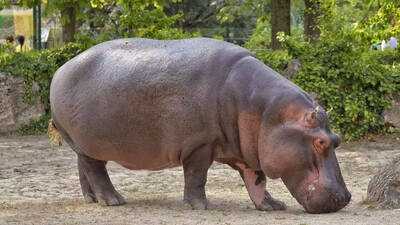
Though not commonly associated with long tongues, the hippopotamus possesses a surprisingly lengthy one, up to 60 centimetres in adults. This large, muscular tongue assists in manipulating and swallowing the vast amounts of vegetation hippos consume daily. In addition to feeding, the tongue plays an important role in communication and social interaction within pods. Its massive size reflects the hippo’s overall anatomy, supporting its heavy jaw structure and complex digestive system. Despite their size and strength, hippos use their tongues delicately when feeding underwater or grazing at night.
7. Woodpecker
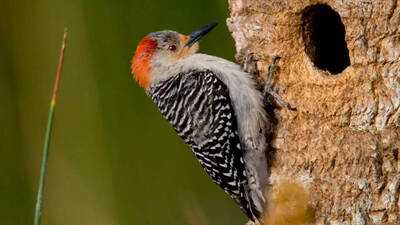
Among birds, the woodpecker stands out for having a tongue that can wrap around the back of its skull when not in use. In species like the red-bellied woodpecker, the tongue can extend far beyond the beak, allowing it to probe deep into tree bark for insects. The tongue’s barbed tip and sticky saliva help the bird extract grubs and larvae hidden within wood. This incredible adaptation not only aids in feeding but also cushions the brain from impact as the bird pecks. It’s a brilliant combination of strength, precision, and evolutionary ingenuity.
8. Penguin

While penguins do not have extremely long tongues, theirs are uniquely adapted to their marine lifestyle. Covered in sharp, backwards-facing spines made of keratin, a penguin’s tongue helps it grip slippery prey like fish and krill. These bristle-like projections prevent prey from escaping as the bird swallows its catch whole. Unlike most birds, penguins’ tongues are not designed for manipulation but for efficient feeding in icy waters. Their tough, spiny tongues are perfect for survival in an aquatic environment where speed and grip mean the difference between a meal and an empty stomach.
9. Eagle
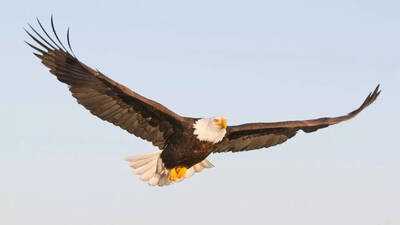
Eagles and many other birds of prey possess tongues adapted more for function than length. Their tongues are lined with backwards-pointing barbs (papillae) that help them grip and swallow chunks of meat. This structure ensures that prey slides down the throat without slipping out, a vital adaptation for hunters that consume live or freshly killed prey. Although not exceptionally long, the eagle’s tongue is muscular and agile, aiding in manipulating food and vocal communication. It showcases how evolution refines structure for efficiency rather than excess.
10. Blue-Tongued Skink
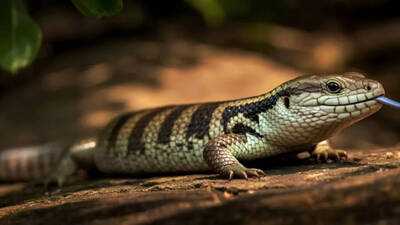
The blue-tongued skink, native to Australia, may not have the longest tongue, but it’s one of the most distinctive. Its broad, blue tongue can extend outward dramatically and is used primarily for defence rather than feeding. When threatened, the skink flashes its vibrant blue tongue to startle predators and deter attacks. The colour contrast is thought to signal toxicity, even though the skink is harmless. Beyond defence, the tongue also plays a role in tasting and scent detection, helping this reptile navigate its environment with remarkable awareness.
From giraffes to chameleons: Discover animals with long tongues
1. Giraffe
The giraffe boasts one of the longest tongues in the animal kingdom, stretching up to 45-50 centimetres. This dark blue-black tongue is prehensile, meaning it can grasp and wrap around objects, ideal for plucking leaves from thorny acacia trees. The dark pigment is believed to protect it from the harsh African sun while feeding for hours each day. Giraffes use their tongues with incredible dexterity, stripping leaves while avoiding sharp thorns. This adaptation not only allows them to reach high foliage inaccessible to other herbivores but also helps sustain their plant-based diet throughout dry seasons.
2. Giant Anteater
The giant anteater has a tongue that can extend up to 60 centimetres, allowing it to raid ant and termite colonies with ease. Lacking teeth, it relies on its sticky, slender tongue, covered in tiny backwards-facing spines and thick saliva, to lap up thousands of insects each day. Its tongue flicks in and out at incredible speed, as many as 150 times per minute, making it one of the fastest in the mammalian world. Uniquely, the anteater’s tongue is anchored near its sternum rather than its throat, giving it extraordinary reach inside narrow nests.
3. Chameleon
Chameleons possess tongues that are as impressive for their length as for their speed. Their elastic tongues can extend up to twice the length of their body, launching outward in less than a second to snatch unsuspecting insects. At the tip, a suction-cup-like pad helps them grasp their prey securely. This lightning-fast mechanism is driven by specialised muscles and elastic tissue that store energy like a spring, making the chameleon's feeding one of nature’s most precise predatory feats. Their tongue is a perfect example of evolution blending power, precision, and speed.
4. Sun Bear
The sun bear, the smallest of the bear species, is also famous for its unusually long tongue, which can reach up to 25 centimetres. This adaptation is essential for feeding; the bear uses it to probe deep into tree trunks, termite mounds, and beehives to extract insects and honey. Its slender, flexible tongue acts almost like a straw, helping it reach hidden food sources that other animals cannot access. This long tongue, combined with strong claws and a keen sense of smell, makes the sun bear a master forager in Southeast Asia’s dense tropical forests.
5. Pangolin
Pangolins are extraordinary insectivores whose tongues can stretch up to 40 centimetres, longer than their entire body (excluding the tail). Unlike most mammals, their tongues are not attached to the floor of the mouth but extend deep into the chest cavity, anchored near the pelvis. This design allows them to probe deep into ant nests and termite mounds. The tongue is coated with sticky saliva, enabling pangolins to gather large quantities of insects quickly. Their feeding style is highly efficient, allowing them to consume thousands of ants and termites in a single night.
6. Hippopotamus
Though not commonly associated with long tongues, the hippopotamus possesses a surprisingly lengthy one, up to 60 centimetres in adults. This large, muscular tongue assists in manipulating and swallowing the vast amounts of vegetation hippos consume daily. In addition to feeding, the tongue plays an important role in communication and social interaction within pods. Its massive size reflects the hippo’s overall anatomy, supporting its heavy jaw structure and complex digestive system. Despite their size and strength, hippos use their tongues delicately when feeding underwater or grazing at night.
7. Woodpecker
Among birds, the woodpecker stands out for having a tongue that can wrap around the back of its skull when not in use. In species like the red-bellied woodpecker, the tongue can extend far beyond the beak, allowing it to probe deep into tree bark for insects. The tongue’s barbed tip and sticky saliva help the bird extract grubs and larvae hidden within wood. This incredible adaptation not only aids in feeding but also cushions the brain from impact as the bird pecks. It’s a brilliant combination of strength, precision, and evolutionary ingenuity.
8. Penguin
While penguins do not have extremely long tongues, theirs are uniquely adapted to their marine lifestyle. Covered in sharp, backwards-facing spines made of keratin, a penguin’s tongue helps it grip slippery prey like fish and krill. These bristle-like projections prevent prey from escaping as the bird swallows its catch whole. Unlike most birds, penguins’ tongues are not designed for manipulation but for efficient feeding in icy waters. Their tough, spiny tongues are perfect for survival in an aquatic environment where speed and grip mean the difference between a meal and an empty stomach.
9. Eagle
Eagles and many other birds of prey possess tongues adapted more for function than length. Their tongues are lined with backwards-pointing barbs (papillae) that help them grip and swallow chunks of meat. This structure ensures that prey slides down the throat without slipping out, a vital adaptation for hunters that consume live or freshly killed prey. Although not exceptionally long, the eagle’s tongue is muscular and agile, aiding in manipulating food and vocal communication. It showcases how evolution refines structure for efficiency rather than excess.
10. Blue-Tongued Skink
The blue-tongued skink, native to Australia, may not have the longest tongue, but it’s one of the most distinctive. Its broad, blue tongue can extend outward dramatically and is used primarily for defence rather than feeding. When threatened, the skink flashes its vibrant blue tongue to startle predators and deter attacks. The colour contrast is thought to signal toxicity, even though the skink is harmless. Beyond defence, the tongue also plays a role in tasting and scent detection, helping this reptile navigate its environment with remarkable awareness.
Next Story